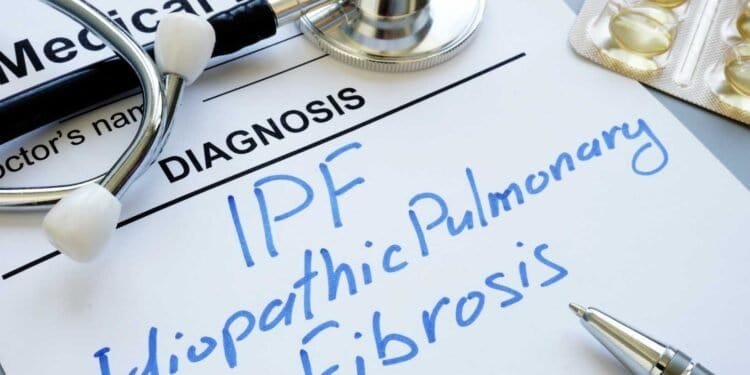Pulmonary fibrosis is a disease that affects the lungs, causing scarring and damage to the tissue. It can make it difficult to breathe and can lead to serious complications. While the exact causes of pulmonary fibrosis are not fully understood, some research has suggested that exposure to certain environmental factors, such as mold, may be a potential risk factor.

Mold is a type of fungus that can grow in damp, humid environments. When mold spores are inhaled, they can cause respiratory problems, including coughing, wheezing, and shortness of breath. Some studies have suggested that exposure to mold may be linked to the development of pulmonary fibrosis, although more research is needed to fully understand this potential connection.
Key Takeaways
- Pulmonary fibrosis is a disease that causes scarring and damage to lung tissue, making it difficult to breathe.
- Exposure to mold may be a potential risk factor for pulmonary fibrosis, although more research is needed to fully understand this connection.
- Prevention and risk reduction strategies, as well as future research directions, are important considerations in addressing the potential link between pulmonary fibrosis and mold exposure.
Understanding Pulmonary Fibrosis
Definition and Pathophysiology
Pulmonary fibrosis is a chronic, progressive lung disease that results in the scarring of the lung tissue. This scarring, also known as fibrosis, causes the lungs to become stiff and less able to expand and contract, making it difficult for patients to breathe. The disease can develop slowly over time, or it can occur suddenly and progress rapidly.
The pathophysiology of pulmonary fibrosis involves the accumulation of scar tissue in the lungs, which gradually replaces healthy lung tissue. This process is triggered by a variety of factors, including exposure to environmental toxins, viral infections, and autoimmune diseases. The accumulation of scar tissue leads to a decrease in lung function and can ultimately result in respiratory failure.
Epidemiology of Pulmonary Fibrosis
Pulmonary fibrosis is a relatively rare disease, affecting approximately 200,000 people in the United States each year. The disease is more common in older adults, with the majority of cases occurring in individuals over the age of 60. Men are also more likely to develop the disease than women.
There are several risk factors associated with pulmonary fibrosis, including cigarette smoking, exposure to environmental toxins such as silica and asbestos, and certain medical conditions such as rheumatoid arthritis and lupus. While the exact cause of pulmonary fibrosis is not fully understood, it is believed to be a combination of genetic and environmental factors.
In conclusion, understanding the definition and pathophysiology of pulmonary fibrosis, as well as its epidemiology, is crucial in developing effective treatments and preventative measures. While the disease is relatively rare, it can have a significant impact on the lives of those affected, making continued research and education essential.
Mold Exposure and Health

Types of Mold
Mold is a type of fungus that grows in damp and humid environments. There are many different types of mold, and some are more harmful than others. Some common types of mold include Aspergillus, Penicillium, and Stachybotrys.
Health Effects of Mold Exposure
Exposure to mold can cause a variety of health problems, especially for people with weakened immune systems or respiratory issues. Some common symptoms of mold exposure include coughing, wheezing, and shortness of breath. In severe cases, exposure to mold can cause lung infections or even lead to the development of pulmonary fibrosis.
It is important to note that not all molds are harmful, and some people may not experience any health effects from exposure to mold. However, it is always best to take precautions to prevent mold growth in the home and to address any mold issues promptly. This can include keeping humidity levels low, fixing any leaks or water damage, and regularly cleaning and ventilating areas prone to mold growth.
Investigating the Link

Mold as a Potential Risk Factor for Pulmonary Fibrosis
Pulmonary fibrosis is a condition that causes scarring of the lungs, leading to breathing difficulties and decreased lung function. While the exact cause of pulmonary fibrosis is unknown, exposure to certain environmental factors has been linked to the development of the disease. Mold is one such factor that has been suggested as a potential risk factor for pulmonary fibrosis.
Mold is a type of fungus that grows in damp environments, such as bathrooms, kitchens, and basements. When mold spores are inhaled, they can cause a range of respiratory symptoms, including coughing, wheezing, and shortness of breath. In some cases, exposure to mold has been linked to the development of pulmonary fibrosis.
Current Research and Findings
Research into the link between mold exposure and pulmonary fibrosis is ongoing. While some studies have suggested a potential association between the two, others have found no significant link.
One study published in the American Journal of Respiratory and Critical Care Medicine found that exposure to mold was associated with an increased risk of pulmonary fibrosis. However, the study was limited by its small sample size and the fact that it relied on self-reported exposure to mold.
Another study published in the International Journal of Environmental Research and Public Health found no significant association between mold exposure and pulmonary fibrosis. The study included a larger sample size and used objective measures of mold exposure, but it was limited by its cross-sectional design, which makes it difficult to establish causality.
Overall, more research is needed to fully understand the potential link between mold exposure and pulmonary fibrosis. In the meantime, individuals who are concerned about mold exposure should take steps to reduce their exposure, such as keeping their home dry and well-ventilated and addressing any water damage or leaks promptly.
Clinical Presentation of Pulmonary Fibrosis

Symptoms
The symptoms of pulmonary fibrosis can be subtle and develop gradually over time. Patients may experience shortness of breath, which can worsen during exercise or physical activities. A persistent cough is also a common symptom, which may produce sputum or blood. Patients may also experience fatigue, weight loss, and chest discomfort or pain.
Diagnosis Procedures
Diagnosis of pulmonary fibrosis involves a thorough medical history, physical examination, and a series of diagnostic tests. A chest X-ray or CT scan may be ordered to evaluate the extent of lung damage. Pulmonary function tests can assess lung function and determine the severity of the disease. In some cases, a lung biopsy may be necessary to confirm the diagnosis.
It is important for patients experiencing any of these symptoms to seek medical attention promptly. Early diagnosis and treatment can help slow the progression of the disease and improve quality of life.
Treatment Strategies
Pharmacological Interventions
There is currently no cure for pulmonary fibrosis, but there are medications that can help slow down the progression of the disease and manage symptoms. Some of the medications that may be prescribed include:
- Corticosteroids: These drugs can help reduce inflammation in the lungs and may be prescribed in the early stages of the disease.
- Immunosuppressants: These drugs may be prescribed to help reduce inflammation and slow down the progression of the disease.
- Antifibrotic agents: These drugs can help slow down the scarring process in the lungs and may be prescribed in the later stages of the disease.
It is important to note that these medications may have side effects and should only be taken under the guidance of a healthcare professional.
Lifestyle and Supportive Care
In addition to medication, there are lifestyle changes and supportive care measures that can help manage symptoms and improve quality of life for individuals with pulmonary fibrosis. Some of these measures include:
- Oxygen therapy: Supplemental oxygen may be prescribed to help improve breathing and increase oxygen levels in the blood.
- Pulmonary rehabilitation: This is a program that includes exercise, breathing techniques, and education to help individuals with pulmonary fibrosis manage their symptoms and improve their overall health.
- Nutritional support: A healthy diet can help improve overall health and may be particularly important for individuals with pulmonary fibrosis.
- Avoiding exposure to environmental irritants: This includes avoiding exposure to mold, dust, and other environmental irritants that may exacerbate symptoms.
It is important to work closely with a healthcare professional to develop a treatment plan that is tailored to the individual’s needs and preferences.
Prevention and Risk Reduction
Environmental Controls
Preventing mold growth in the home is crucial for individuals with pulmonary fibrosis. Mold can grow in areas with high humidity, such as bathrooms, kitchens, and basements. To prevent mold growth, individuals should keep their home dry and well-ventilated. This can be achieved by using dehumidifiers, opening windows, and using exhaust fans in bathrooms and kitchens. Regularly cleaning and drying surfaces that are prone to moisture, such as shower curtains and bath mats, can also help prevent mold growth.
Occupational Safety
Individuals who work in industries that involve exposure to mold, such as construction and agriculture, are at an increased risk of developing pulmonary fibrosis. To reduce this risk, employers should provide appropriate protective equipment, such as respirators and gloves, and ensure that workers are trained on how to use them properly. Employers should also implement measures to control mold growth in the workplace, such as regular cleaning and maintenance of ventilation systems.
It is important to note that while these measures can help reduce the risk of mold exposure, they may not completely eliminate the risk. Individuals with pulmonary fibrosis should consult with their healthcare provider for personalized recommendations on how to reduce their risk of exposure to mold.
Future Research Directions
Emerging Therapies
As research continues to uncover the potential link between pulmonary fibrosis and mold exposure, there is a growing need for effective treatments. While there are currently no FDA-approved therapies for mold-related pulmonary fibrosis, there are some emerging therapies that show promise.
One such therapy is the use of anti-fibrotic drugs, which have been shown to slow the progression of pulmonary fibrosis in some patients. Other potential therapies include stem cell therapy and gene therapy, although more research is needed to determine their effectiveness.
Longitudinal Studies
Longitudinal studies are critical to understanding the long-term effects of mold exposure on pulmonary fibrosis. These studies follow patients over time and can provide valuable information on disease progression, risk factors, and potential treatments.
In addition, longitudinal studies can help identify biomarkers that may be used to diagnose pulmonary fibrosis at an earlier stage. This could lead to earlier interventions and better outcomes for patients.
Overall, future research should focus on identifying effective therapies for mold-related pulmonary fibrosis, as well as improving our understanding of the disease through longitudinal studies. With continued research, we can hope to improve the lives of those affected by this debilitating condition.
Public Health Considerations
Awareness and Education
Given the potential link between pulmonary fibrosis and mold exposure, it is important for the public to be aware of the risks associated with mold exposure. This includes educating individuals on how to identify and prevent mold growth in their homes and workplaces. Additionally, individuals with pre-existing respiratory conditions should be made aware of the potential health risks associated with mold exposure.
Public health campaigns and educational materials can be used to increase awareness and knowledge about the potential risks of mold exposure. These materials can be disseminated through a variety of channels, including social media, community events, and healthcare providers.
Policy and Regulation
Regulatory agencies play an important role in ensuring that individuals are protected from potential health hazards associated with mold exposure. In the United States, the Environmental Protection Agency (EPA) sets guidelines for indoor air quality, including acceptable levels of mold.
Additionally, some states have established regulations regarding mold remediation in homes and workplaces. For example, in California, contractors who perform mold remediation must be licensed by the state.
It is important for policymakers to continue to evaluate and update regulations related to mold exposure to ensure that individuals are adequately protected from potential health risks. This includes considering the potential health risks associated with mold exposure when developing building codes and regulations.
Frequently Asked Questions
What are the common symptoms associated with advanced stages of pulmonary fibrosis?
The symptoms of pulmonary fibrosis can vary depending on the severity of the disease. In advanced stages, patients may experience shortness of breath, dry cough, fatigue, weight loss, and chest pain. The symptoms may worsen over time, making it difficult for patients to perform daily activities.
Can exposure to environmental molds contribute to the development of pulmonary fibrosis?
There is some evidence to suggest that exposure to environmental molds may contribute to the development of pulmonary fibrosis, particularly in individuals who are genetically susceptible. However, more research is needed to establish a clear link between mold exposure and the onset of pulmonary fibrosis.
What are the primary risk factors associated with the onset of pulmonary fibrosis?
The primary risk factors associated with the onset of pulmonary fibrosis include age, smoking, genetics, exposure to environmental toxins, and certain medical conditions such as autoimmune diseases and gastroesophageal reflux disease (GERD).
How can pulmonary fibrosis lead to fatality, and what are the mechanisms involved?
Pulmonary fibrosis can lead to fatality due to the progressive scarring of lung tissue, which can make it difficult for the lungs to function properly. As the disease progresses, patients may experience respiratory failure, which can be life-threatening. Other complications associated with pulmonary fibrosis include pulmonary hypertension, heart failure, and lung cancer.
Is there any emerging treatment that could be considered a breakthrough for pulmonary fibrosis?
There are several emerging treatments for pulmonary fibrosis, including medications that target specific pathways involved in the development of the disease. These treatments are still in the early stages of development and require further study to determine their effectiveness.
What types of lung scarring are commonly seen in patients with pulmonary fibrosis?
Patients with pulmonary fibrosis often have a specific type of lung scarring known as usual interstitial pneumonia (UIP). This type of scarring is characterized by the formation of fibrous tissue in a pattern that is typically patchy and irregular. Other types of scarring may also be present, depending on the underlying cause of the disease.














